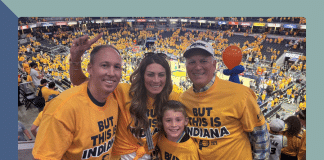Finally, we are entering a cooler season in Indiana, complete with pumpkin spice everything, boots with leggings (what I refer to as amateur equestrian garb), and ridiculous chunky scarves that look like a furry, outer-space caterpillar swallowed someone’s head. For many, this dip in temperature also means it’s time to stoke up our indoor fireplaces to bridge that gap between windows-open and full-on heater weather. Because of the ease and maintenance, most modern homes have gas fireplaces, many of which are glass-front. Heck, even my 113-year-old house has had both original fireplaces replaced with glass-front gas. As nice as these can be for ambiance and warmth, they can be a nightmare for families with kids. This is my PSA about fireplace safety from someone who has lived that nightmare.
In January of 2014, I dropped my 14-month-old son at his in-home daycare and headed to work as usual. I was ten minutes down the road after leaving him that I received a call from our daycare provider.
“Lindsay, I looked away from Oliver for a second. He touched the glass on our fireplace and burned his hand.”
Not one to panic, I replied casually, “Oh, no. Is he okay?”
“It seems kind of bad. You should probably come to get him.”
This will forever go down in my experience as the understatement of the century.
I rushed back to her house. The babysitter answered the door holding Oliver who was screaming–the type of inconsolable screaming that makes you think he might throw up or pass out. I swooped him into the car without asking questions and sped to the emergency room just down the street. Tears were streaming down my face as I tried to console my little man, strapped in his car seat when all I wanted to do was hold him.
My recollection of our time at the emergency room is a blur of tears, Oliver screaming, me sweating while trying to wrestle with him as I filled out forms. After what felt like an eternity, a nurse was able to administer some pain meds to calm him down. The doctor on duty took one look at his hands, took a deep breath, “These burns are not something we are going to be able to treat. We need to get you to the burn clinic at Riley.” Okay. Let’s go. Point me in the right direction. “Unfortunately, they aren’t open today.” Perfect.
They wrapped Oliver’s hands, sent us home with the strongest pain meds a toddler can handle, and scheduled our appointment with the premier burn doctor in the Midwest for the following morning. Thus began a journey that continues to this day, four years later.
A journey that Oliver will be on through adulthood.
Oliver sustained full-thickness burns on his palm. (This is what is commonly referred to in television shows as “third-degree” burns.) Imagine the tiny hand of a baby. Now imagine the entire palm covered in a white blister an inch thick. After the doctor and his team of nurses performed the gruesome task of removing the blister, they were able to determine that because of the severity of the burns, his skin would not be able to repair itself. He would require skin graft surgery. Our doctor has seen many of these burns. By looking at it, he felt pretty confident that Oliver had probably touched the glass on the fireplace for about two seconds at the most. Two seconds.
I’ll spare you the horrible details of waiting for surgery with a starving baby, meeting with countless doctors regarding the risks of every aspect of the surgery (one doctor had to explain to us that by applying leg skin to my son’s hand, he would possibly grow leg hair on his palms during puberty. Wait, what?), kissing him goodbye as they took him back, waiting in a cold room with vending machine snacks. Finally, the doctor returned. The surgery was a success. (I was unsure that the word success could be applied to this situation.) They removed a 4 x 3-inch rectangle of skin from his thigh and attached it to his right palm. We were warned that the graft site would probably be more painful for Oliver than the actual palm. Again, perfect.
Oliver and I spent five days inpatient on the burn unit. Anyone who has spent time in a hospital with a child knows how awful that experience is. Sleepless nights with a baby who doesn’t understand what is happening. Very little eating. Even less showering. Boredom. Tears. Once a day, a group of 5-7 nurses and residents (and the magical Child Life specialist) would gown up and take us to a sterile room to change the dressing on his hand. It was pure torture. For all of us.
We were discharged with the world’s largest supply of creams and bandages, the world’s longest list of instructions for stretching and cleaning both wounds, and the world’s biggest lump in my throat from the fear of messing it up. We spent the next two months at Riley at least once a week for physical and occupational therapy and visits with the burn specialists. Oliver was proving to be a “difficult” patient. Complications arose that “never” happen. Of course. After two months of battling complications, the team at Riley determined the first surgery was a failure (i.e., the opposite of success). We were scheduled for repeat surgery. Another skin graft from the same location. Five more days in the hospital. Perfect.
We spent the next year recovering from the second surgery. To proactively prevent the complications that arose the first time, Oliver was placed in a cast for the better part of 3 months. We burned a path from the parking lot to the burn unit, with visits at least once a week. Eventually, Oliver graduated from a cast to a compression glove that he wore day and night to allow the scar to heal properly. We did nightly scar massage, which involved me wrapping my legs around him to do my best to contain his thrashing and screaming. (Did I mention how strong he was?) In addition to the actual scars, Oliver developed an extreme fear of any situation that he perceived as a “procedure.” Haircuts became impossible—so we gave up and let his hair grow. Dentist—impossible. At one burn clinic appointment, the Child Life staff filmed the procedure to use as a learning tool. The screaming on that video still haunts me.
Since that second surgery, Oliver has had another surgery to expand the scar tissue to keep up with his growing hand. He will have at least one, but probably two more surgeries before he turns 18. He will live with the scar on his hand until the day he dies. We have officially entered the point in his childhood that I’ve dreaded—when the kids in his class refuse to be his line partner so they don’t have to hold his hand. He is a tough kid, but I am a mess when I think about how two seconds of his life has caused so much pain. You get it. It’s awful.
Here’s the fireplace safety PSA:
All gas-front fireplaces should have a protective mesh screen attached to them, to protect from these types of burns.
Unfortunately, many are not installed with this screen, mainly because they aren’t aesthetically pleasing, or the contractor just neglects to do it. Check yours now. If it doesn’t have the screen, search your closets for where it was stashed, or order a new one from the manufacturer. The surface of a gas-front fireplace can get up to 500 degrees and can remain up to 300 degrees even 30 minutes after turning it off. Very few fireplace manufacturers make these warnings obvious. Also, if your child is a childcare situation that is not certified by a governing body, make sure that they understand fireplace safety.
Many people have said, “If you are watching your child properly, this won’t happen” Let’s be real people. Nobody—even the best parent or care provider among us – can watch a toddler constantly. Two seconds was all it took.
We have never turned on the fireplaces in our new home. I obsessively check all fireplaces in friends’ homes or Air BNBs. I love a fire on a cool night as much as the next, but I am haunted by the daily reminders of those two seconds of ignorance. Hopefully, our painful lesson can prevent you from experiencing the same.









This is devastating. It reminds me very much of the things my sister had to go through as a childhood leukemia patient. So sad for you and I appreciate the way you are not disrespectful to the day care provider, even in such a terrible circumstance.
Wow! Thank you for sharing this traumatizing story as a PSA!! So just so I’m clear – the mesh goes between the glass and the fire? How does that protect from burns? I just tested it and I could still touch the glass.
It should attach on the outside of the glass (which is why a lot of builders don’t attach it–it’s not as pretty as the bare glass.) Each model is different, so if you have questions, you should consult the manufacturer! Thanks!
Thank thank thank you for sharing this. Just like pool safety- fire safety of any kind is so important. You are so brave to have gone through this with your child. The fireplace I grew up with- which we hardly used ONLY had a mesh screen, which still remains today. I will make sure when we sell it (it flooded during Harvey) that the buyers know about fireplace safety.
Comments are closed.